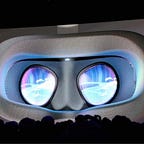What EEG Can Bring to Your VR Experience
Article written by Fifer Garbesi for VRMA.io Virtual Reality Media
Regarding the 8th Augmented World Expo AWE2017
Listen to the latest Episode of the Neural Lace Podcast at Soundcloud
https://soundcloud.com/user-899513447/the-neural-lace-podcast-7-guest-android-jones
Also read Micah Blumberg article about the Neural Lace Podcast #7 called “The brain as a special kind of hard drive.” https://vrma.work/2017/06/11/the-brain-as-a-special-kind-of-hard-drive-android-jones-the-vision-agency-microdose-vr-eeg-muse-awe2017-nvidias-gpu-cloud-and-the-neural-lace-podcast-7/
Excited about mind control in VR? Well, we’re not quite there yet Neuroscientists describe existing EEG technology as “a microphone placed outside a football stadium; you can hear when there is action, but you can’t really tell what the score is”. However, while EEG may not be accurate enough for active BCI (brain computer interface), it can provide adequate information to describe the mind state of the wearer.
The Muse set for HTC Vive consists of 8 EEG sensors incorporated elegantly into the headset, with a small plastic insert and additional sensors on the foam of the eyepiece, painted on with conductive material.
What this 8 Channel EEG data can tell us about our brain is what state we are in by measuring the waves of data. The slower waves, from 3–12 Herz are associated with sleep or meditation while Beta waves (12–38 Herz) are normal thought processes.
Naturally, the primary focus of the Muse team is to provide biofeedback for people trying to get into a meditative state. With their app and a simple Muse band with forehead and ear sensors, you can practice your meditation with the sounds of the beach. In Beta state, the weather is stormy. When you achieve a tranquil state, the beach calms and waves gently lap the shore. This kind of feedback can prove a useful guide is judging your progress in meditation. Digital Artist Android Jones said he “values the benefits, but had a difficult time being bored and settling [his] mind through traditional meditation.”
Now, Jones has incorporated the Muse into the newest version of his famous psychedelic drawing experience, Microdose VR. If you can maintain a meditative state you see the sky part in the experience.
“You’re seeing a purely organic reflection of yourself reflected digitally,” shared Jones. “You need an outer reflection to tune in to that. We’re using environmental elements to create that connection.”
Jones also uses a heartbeat monitor to provide additional biofeedback signals. “You can see your heartbeat pulsing in front of you. Pulse is giving us the most reliable reflection.”
He is very excited for the future of this merger of VR and Neuroscience saying that “this is our first foray into this, but it represents a deeper level of technological intimacy.”
While Jones may be excited about the possibilities for self-improvement, EEG integration into VR presents privacy problems which far surpass our current legal infrastructure. The data collected from biofeedback in VR will give companies incredibly personal information about who we are. They might even be able to gauge our sexual orientation before we are aware of it ourselves. It’s up to early users to push VR platforms to take a stand in protecting this data.
Listen to the latest Episode of the Neural Lace Podcast at Soundcloud
https://soundcloud.com/user-899513447/the-neural-lace-podcast-7-guest-android-jones
Also read my article about the Neural Lace Podcast #7 called “The brain as a special kind of hard drive.” https://vrma.work/2017/06/11/the-brain-as-a-special-kind-of-hard-drive-android-jones-the-vision-agency-microdose-vr-eeg-muse-awe2017-nvidias-gpu-cloud-and-the-neural-lace-podcast-7/
